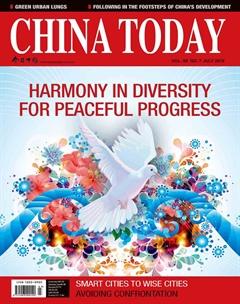Huawei’s World View
Huaweis World View
Xinmin Weekly
Issue No. 21, 2019
According to Orville Schell, director of the Center on U.S.-China Relations at the Asia Society, Huawei is quite an extraordinary company doing quite creative business, with admirable overseas market coverage. However, if there is a field that has the possibility of splitting, it would be 5G telecommunication network.
As one of the drafters who submitted a report on policy toward China to the U.S. Congress in February 2019, Schell admitted that 5G is so important that all other technologies must be based on it. In view that Chinas political system, values, and goals are completely different from those of the United States, this may be an area that will split the two countries, and taking no exceptions, Huawei is likely to become a victim.
Indeed, on January 29, 2019, the U.S. Department of Justice filed 23 accusations against Huawei and its subsidiaries. On May 15, the U.S. Department of Commerce placed the Chinese telecom giant on the export control entity list. The Trump Administration has been launching continuous attacks on Chinese high-tech companies and the entire Chinese high-tech manufacturing industry.
But Aleksey Maslov, head of the School of Asian Studies at the Russian National Research University Higher School of Economics, sees yet another problem in the U.S. policy: even if the U.S. wants to engage in long-term strategic competition with China, it does not know what the ultimate relationship should be with this opponent.
Keeping the Capital
South Reviews
Issue No. 11, 2019
In March 2016, the stock issuance registration system reform was officially put on the agenda. After three years, this game-changing reform is still in progress.
In November 2018, the reform of science and technology innovation board was officially launched. The board is built to implement the reform policies, and is also an attempt to adjust the relations between the central and local governments in the capital market since the 1990s.
A good company does not necessarily mean technological innovation. In those economies that have long lacked technology accumulation and implemented a franchised system in stock market issuance, over-emphasis on technology may make initial public offering a wealth transfer under the pseudo-concept of innovation. This kind of risk can only be solved by market rules.
Despite this fact, major economies need a capital market that can effectively allocate resources. Especially in the critical period of economic transformation, only the market mechanism provides opportunities to those companies that continue to heal the economy through innovation, rather than merely letting the companies which are making no profits take the money under the concept of innovation and then disappear.
The world is getting flatter and flatter, giving capital flow more access to more markets. There is no market that is an independent island.
Technology Changes Childhood
Sanlian Lifeweek
Issue No. 22, 2019
From the beginning, humans have always depended on technology, and the use of tools was once one of the fundamental characteristics that distinguished them from all other species. The reason why human childhood exists is to give humans time to learn, cope with change, and explore the unknown.
In fact, almost all new technology has triggered adult panic. Ancient Greek philosopher Socrates believed that reading and writing causes catastrophic damage to the memory. Novels, telegraphs, telephones, and television have all been declared the end of civilization. These different kinds of technology are much more troublesome for adults than for young people, a big reason for this being that childrens brains are more flexible than adults and are better at mastering these new technologies.
Undoubtedly, our technology today opens a wider and freer world for children. Childrens compassion, imagination, social skills, and problem-solving skills have traditionally been acquired while playing in the natural environment.
As parents, we just need to accompany our children to understand, explore, and experiment, even when we see new possibilities or potential dangers that will influence the growth of our children.
Golden Goose of Elderly Care
China Financial Weekly
Issue No. 11, 2019
China is experiencing the worlds largest, fastest, and longestlasting period of aging. According to the National Bureau of Statistics, by the end of 2018, Chinas population aged 60 and above had reached 249 million. As the growth rate of the aging population continues to increase, many research reports predict that Chinas aging population will reach around 400 million in 2030, accounting for about a quarter of the countrys population.
Looking on the bright side of the cumbersome burden is a promising industry with its huge development potential. The White Paper on Chinas Elderly Care Industry Development issued by the Chinese Academy of Social Sciences predicted that the market size of the elderly care industry is expected to reach RMB 13 trillion by 2030.
The lucrative industrial prospect has attracted competing capital. The problems of high operating costs, difficulty in profitability, and incomplete supporting policies are constantly revealed in development and are constantly solved during development. Private investment has never been so anxious to explore a profitable model for the sector.
The Chinese government attaches great importance to this industry and introduced a raft of supporting policies, which include canceling administrative approval for the establishment of elderlycare facilities, opening the market to private investment, supporting training for nursing professionals, and raising the basic pension for retirees.

